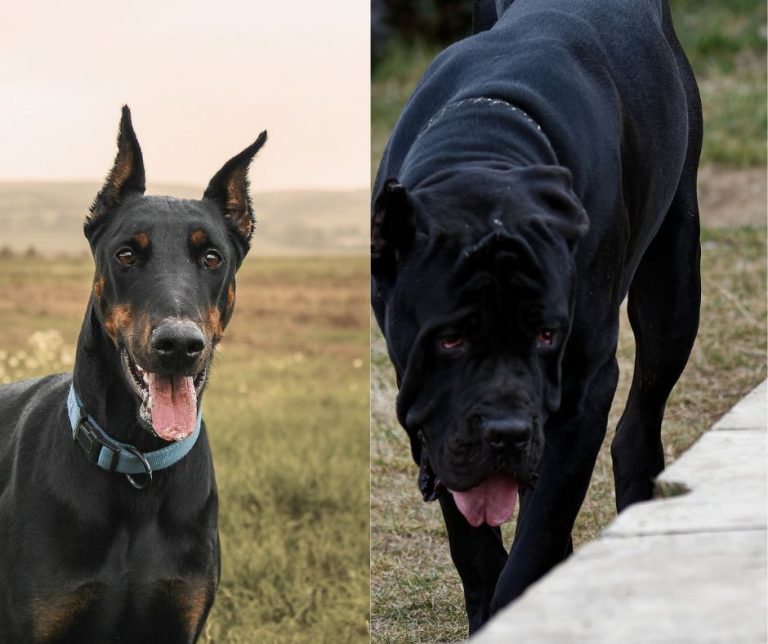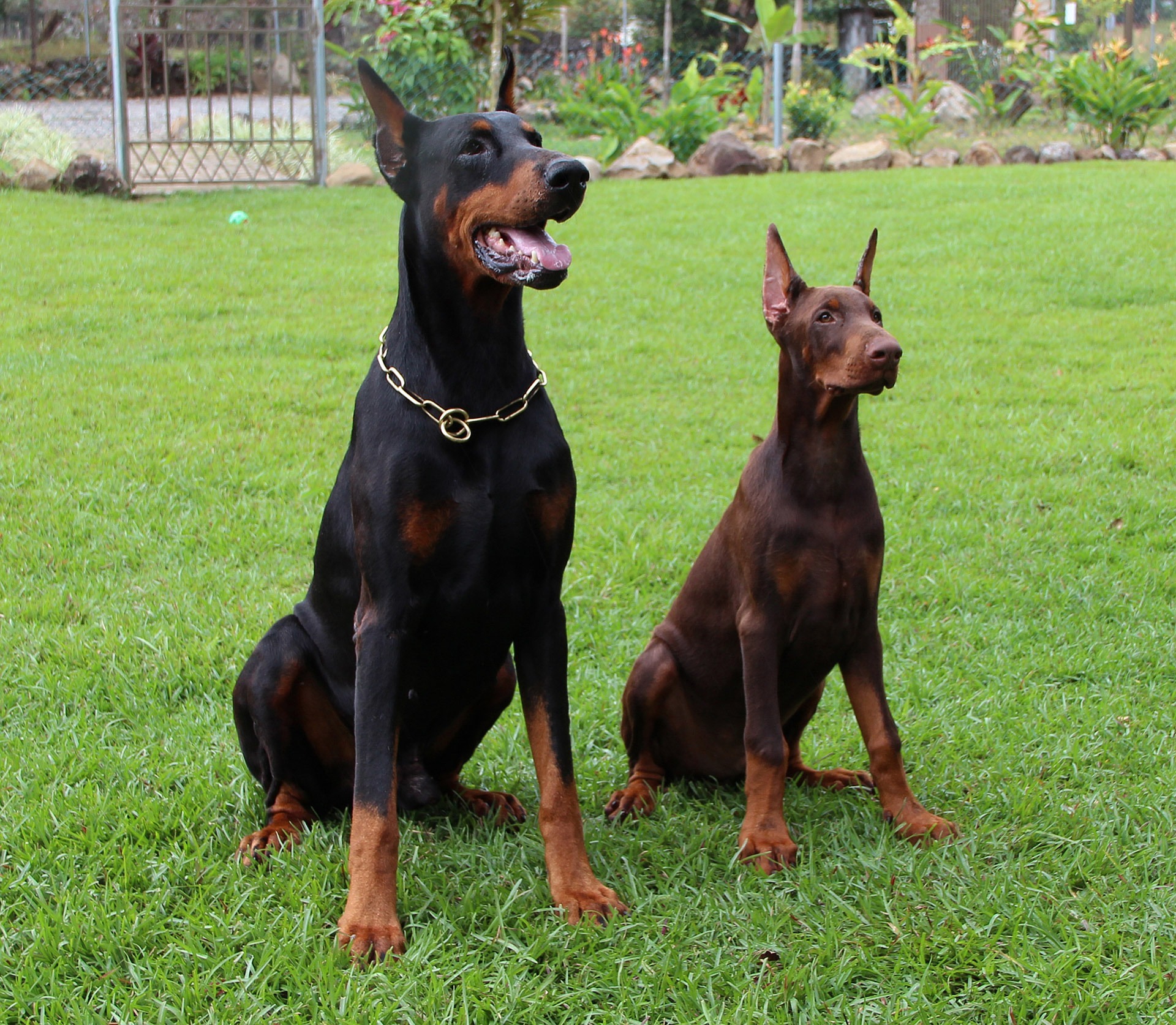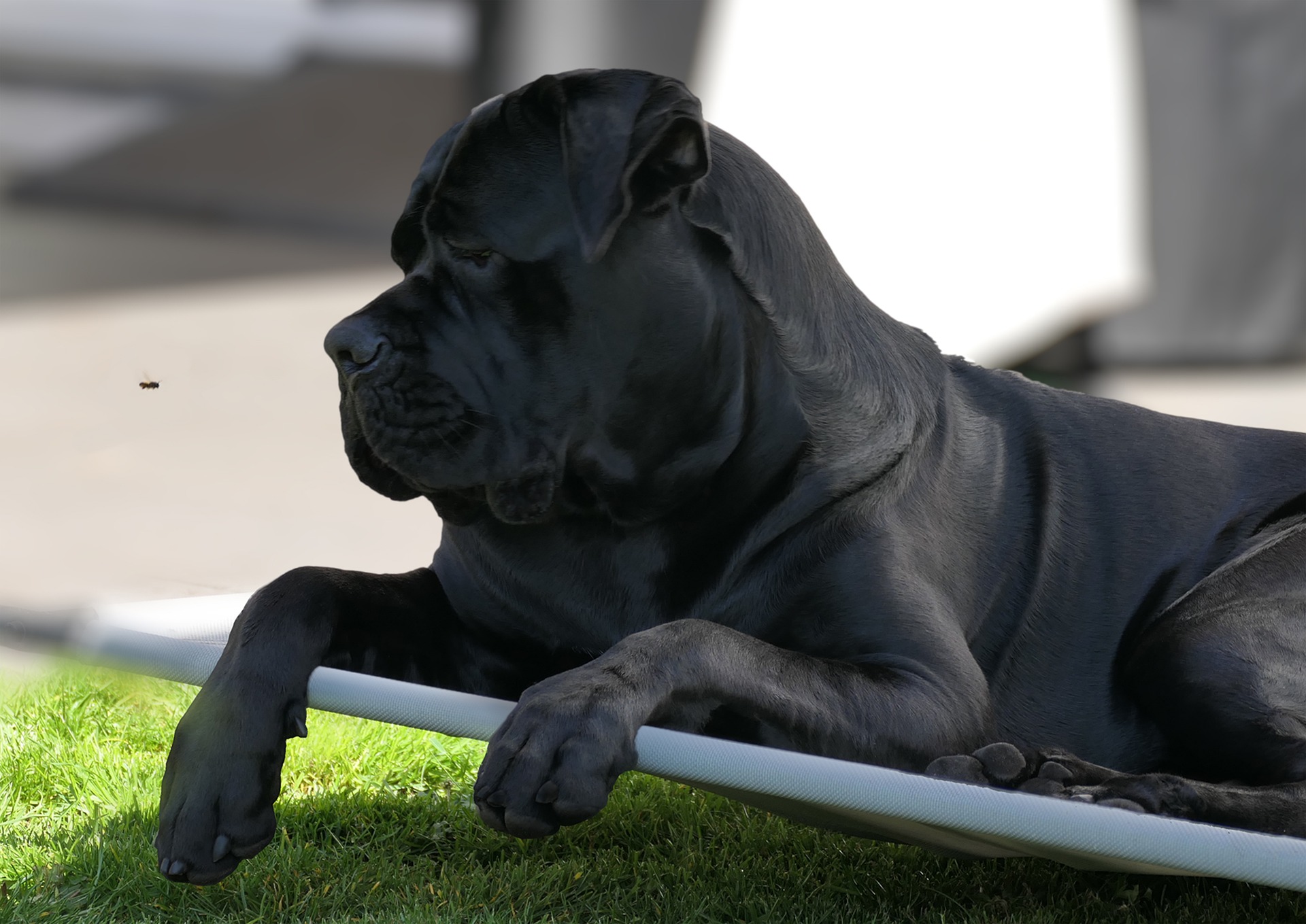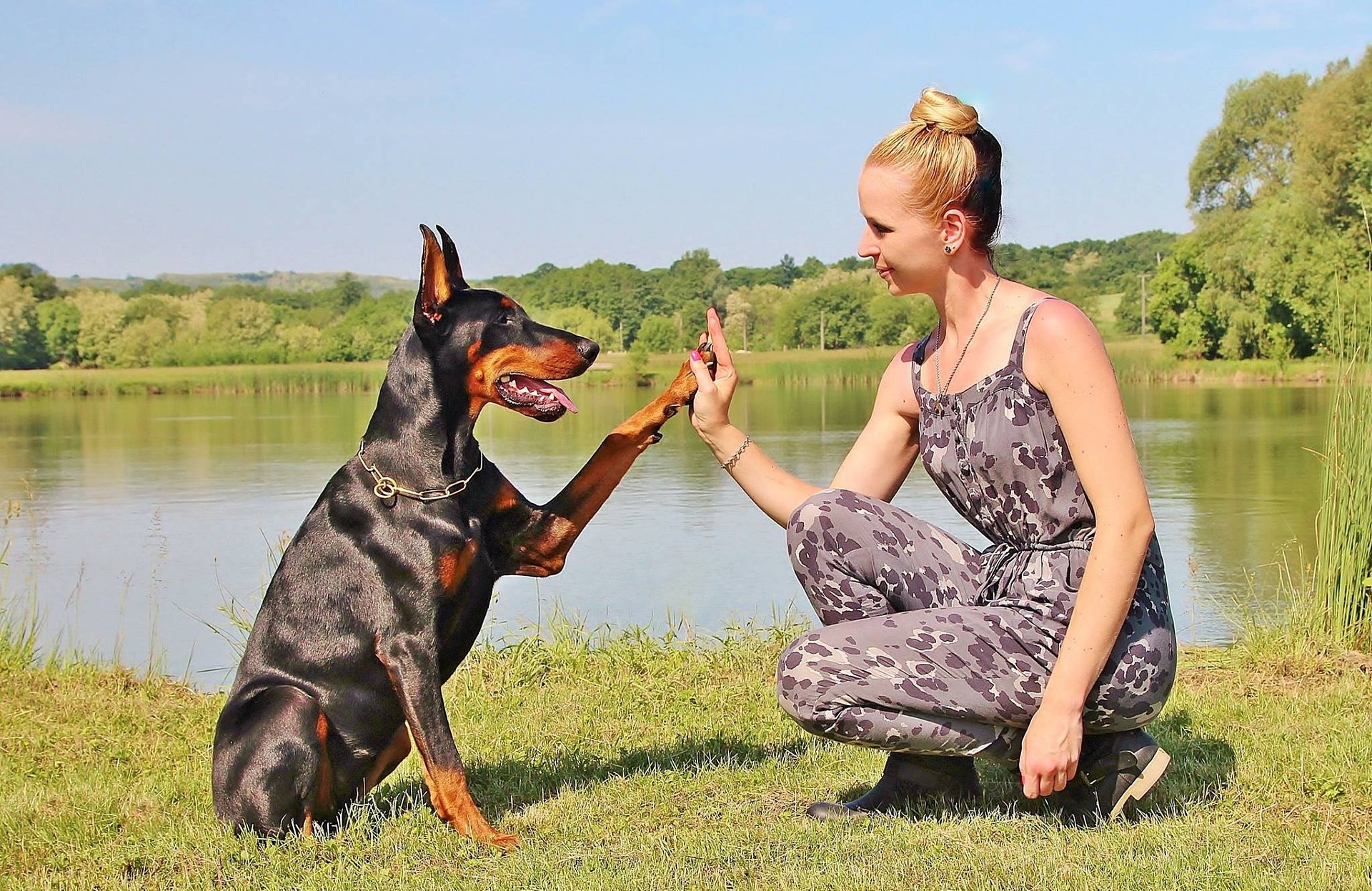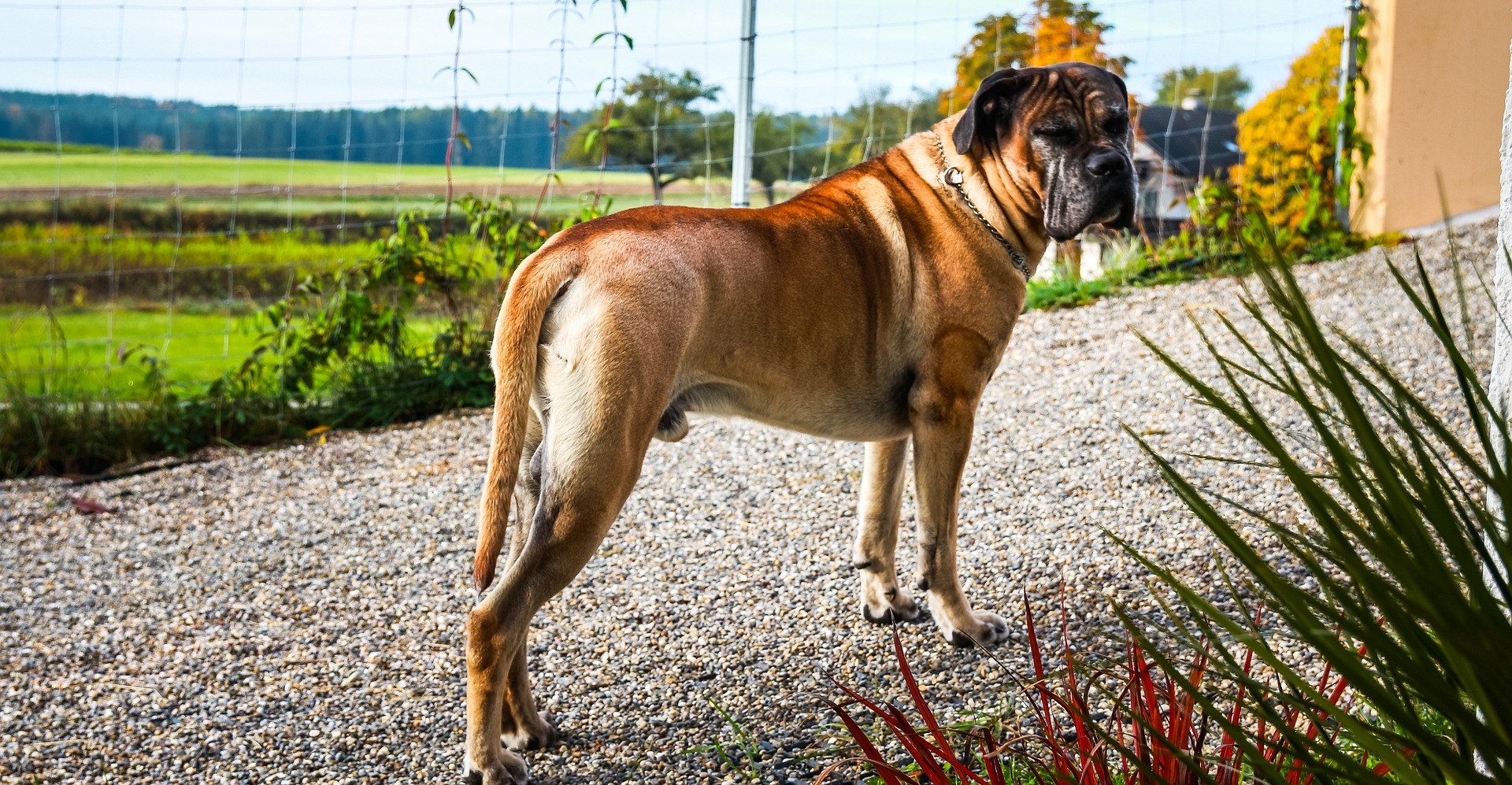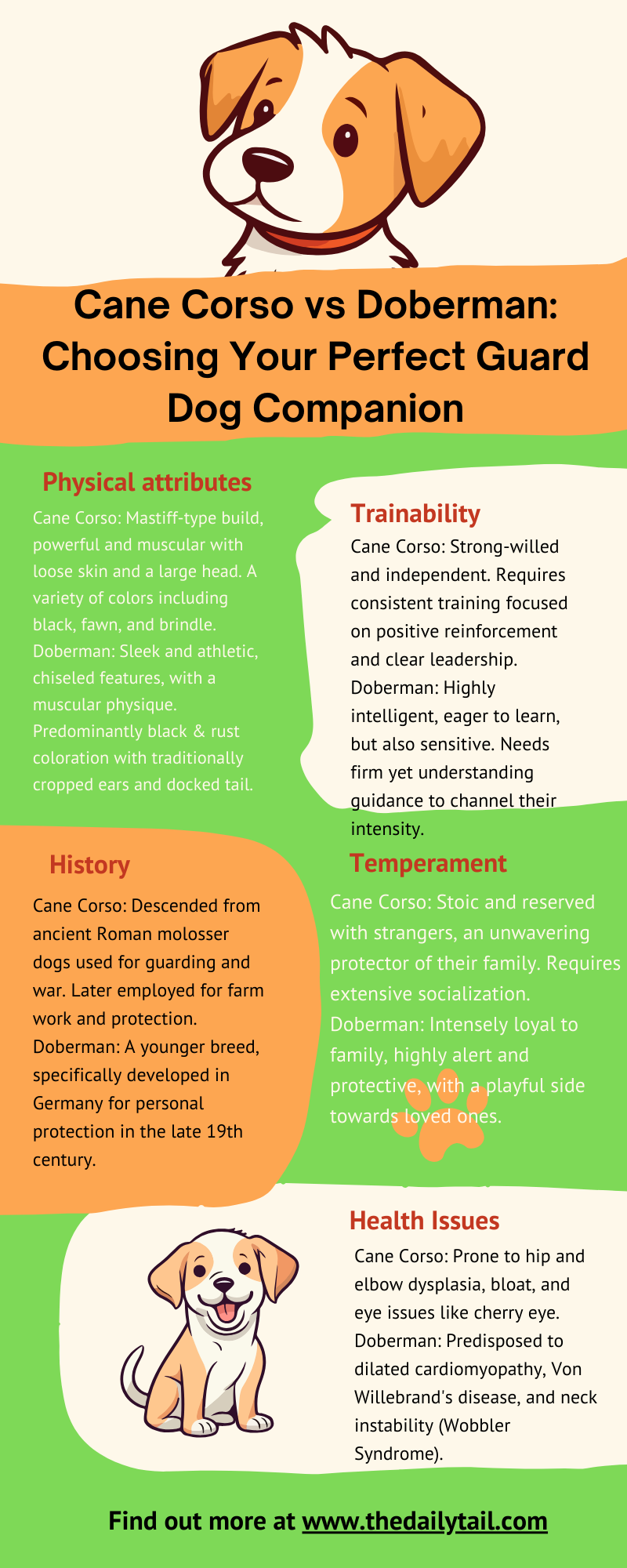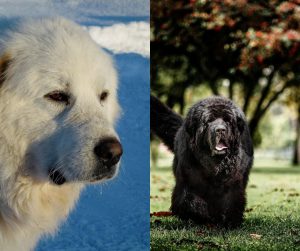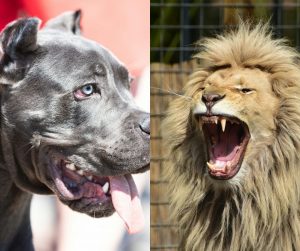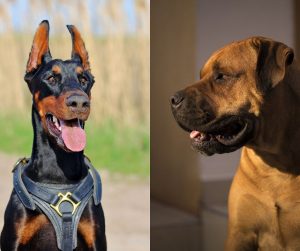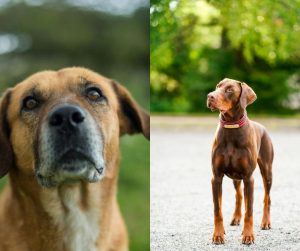They’re both intimidating protectors, but the Cane Corso and Doberman offer vastly different experiences. Let’s break down what lies beneath the powerful image.
When choosing between Cane Corso vs Doberman, prospective pet owners are comparing two of the most impressive guard dogs bred for strength, loyalty, and a commanding presence. However, their similarities as protective companions belie their distinct differences, which are crucial for an owner to understand in order to ensure a harmonious match with their lifestyle and expectations.
The Cane Corso is an Italian breed known for its large, muscular frame, a clear indicator of its historic role as a capable protector of property and family. The Doberman, by contrast, boasts a sleeker build, reflecting agility alongside strength. Both breeds project confidence and intelligence, but their approaches to training, socialization, and exercise differ significantly—facts that are vital for anyone considering these breeds to take into account.
Key Takeaways
- Cane Corsos are larger and more muscular than sleeker Dobermans
- Though both breeds are intelligent, their training and socialization needs differ
- Potential owners need to consider the breeds’ distinct exercise requirements and energy levels
Breed Origins and History
Choosing between a Cane Corso dog breed and a Doberman Pinscher isn’t just about appearances or temperament; it’s dipping into a deep well of history. These dogs came from distinct origins and have been shaped into the admirable guard and working dogs we know today through centuries of purpose and passion.
Cane Corso Origins
The story of the Cane Corso began in Italy, where they served as mighty guardians and working dogs. Rooted in antiquity, these robust canines are the descendants of the Roman war dogs known as ‘molossus.’ The name ‘Cane Corso‘ itself gives a nod to its past, combining the Italian ‘Cane’ (dog) and Latin ‘Cohors’ (guardian), painting a picture of resilience and strength.
Doberman Pinscher Background
Shift the focus to Germany, and you’ll find the inception of the Doberman Pinscher in the latter half of the 19th century. Created by a tax collector named Louis Dobermann, these dogs were intended to be the perfect combination of strength, loyalty, and intelligence. Their role as protectors and loyal companions became evident early on, setting them apart as an unparalleled guard dog breed.
Both breeds carry with them a legacy of protection and companionship, carving out their unique niches in history as defenders of their human counterparts. Whether patrolling an ancient Italian countryside or accompanying a 19th-century German taxman, these dogs have earned their place at the sides of those seeking security and loyalty.
Nowadays, some canine experts say there is a difference between an European Doberman and an American Doberman.
Physical Appearance
When comparing the Cane Corso to the Doberman, their physical appearance showcases distinct breed characteristics that are important for potential owners to consider. From the coat texture to the general size, each breed has its unique visual traits.
Visual Differences
Both the Cane Corso and Doberman carry themselves with a dignified and robust appearance, but they are distinct in their physical make-up. The Cane Corso often presents a more rustic look, with a broader head and a muscular build, while the Doberman has a more sleek and athletic silhouette, marked by a finer, almost aristocratic, head shape.
Coat and Colors
The coats of these two breeds are quite different both in texture and options for colors. The Cane Corso sports a double coat which includes a short, dense undercoat and can come in a variety of colors including black, gray, fawn, and brindle, to name a few. On the other hand, the Doberman is known for its smooth coat that lies close to the body and generally comes in black, red, blue, or fawn with rust markings.
Size Comparison
| Breed | Average Height | Average Weight |
|---|---|---|
| Cane Corso | 23-28 inches | 100-110 pounds |
| Doberman | 24-28 inches | 70-100 pounds |
While both breeds are tall, the Cane Corso can be considerably more bulky and heavier, reflecting its lineage as a powerful working dog. The Doberman is leaner, contributing to its image as a fast and agile guard dog.
Temperament and Personality
When it comes to the Cane Corso vs Doberman behavior comparison, their temperaments and personalities reflect a blend of loyalty, affection, and protective instincts, but they each express these traits uniquely.
Cane Corso Temperament
The Cane Corso is the epitome of a guardian; they are a breed with a formidable presence, matched by an equally imposing personality. Known for loyalty to their family, these dogs often exhibit a protective nature, always on the alert. Despite their robust exterior, Cane Corsos have a loving heart and often form a strong bond with their owners. They carry a mix of determination and calmness, being reserved, especially with strangers. While not inherently aggressive, the breed’s strength necessitates proper socialization and training to ensure that their protective instincts are well-directed.
- Protective Instincts: Very High
- Independence: Moderate to High
- Affection Levels: Loyal and loving with family
Doberman Personality
Dobermans, in contrast, are known for their fearless and alert nature, often serving as loyal companions and vigilant protectors. They excel in being affectionate with their people, demonstrating loyalty and an eagerness to please that balances their fearless disposition. Though they can be somewhat independent, they thrive on companionship and engagement with their human family. It’s essential to channel their intelligence and energy constructively, as a bored or neglected Doberman might develop unwanted behaviors.
- Loyalty: Exceptionally loyal
- Fearlessness: Markedly fearless
- Affectionate Nature: Expresses love openly with trusted individuals
Training and Socialization
When it comes to training and socialization, both the Cane Corso and Doberman stand out with their high intelligence levels, making them capable of learning a variety of tasks. These breeds thrive with proper training and consistent socialization from an early age, laying a foundation for a well-mannered adult dog.
Ease of Training
Cane Corso
The Cane Corso is known for its intelligence and trainability, often showing a strong desire to please their owner. However, they can also exhibit a stubborn streak, which requires a firm and confident hand in training. It’s essential that they receive obedience training to harness their protective instincts properly, especially because they have a history in protection and herding. Using positive reinforcement techniques will lead to the best results with this breed.
- Start training early: ideally between 8 to 12 weeks old
- Be consistent with commands and rules
- Use positive reinforcement: rewards and praises
Doberman
In contrast, the Doberman excels in obedience due to its background as a protection dog. They are eager to learn and respond well to proper training. Owners will find them to be faithful students that pick up new commands quickly, given their high intelligence level. Just like the Cane Corso, the Doberman requires a confident trainer who can provide structure and boundaries.
- Train consistently from a young age
- Provide mental stimulation: trick training and problem-solving games
- Keep training sessions engaging and challenging
Socialization Needs
Cane Corso
The Cane Corso needs thorough socialization to develop into a sociable and well-adjusted dog. Introduce them to a variety of people, pets, and environments early on to foster an even temperament. Without adequate socialization, their protective nature can become overpronounced, leading to unwanted behavior.
- Introduce to new experiences regularly
- Provide exposure to different people and animals
- Encourage positive interactions
Doberman
Similarly, the Doberman benefits greatly from early socialization. They are generally friendly dogs but need exposure to different stimuli to prevent any potential aggressiveness or overprotectiveness. A well-socialized Doberman is typically a friendly and confident companion.
- Socialize from a young age to ensure a well-rounded temperament
- Use regular walks and dog parks for exposure to various scenarios
- Reinforce positive social behaviors
Exercise and Energy Levels
When considering a Cane Corso or a Doberman Pinscher as a pet, it’s important to understand their exercise needs and natural energy levels. Both breeds are known for their athletic prowess and require a significant amount of physical activity to stay healthy and happy.
Exercise Requirements
The Cane Corso is a large and powerful breed that was originally bred for guarding and hunting purposes. They possess a remarkable blend of strength, endurance, and agility, which makes them excel in various canine sports and activities. Exercise needs for a Cane Corso are quite high; they thrive on having a job to do and space to roam. A daily regimen of vigorous exercise, such as long walks, runs, or play sessions, is essential to keep them physically and mentally stimulated.
- Recommended Daily Exercise:
- Adult Cane Corso: At least 90 minutes
- Puppy Cane Corso: Shorter, frequent play sessions
On the other hand, the Doberman Pinscher is renowned for its speed and stamina. This breed has a high energy level and is inherently athletic, capable of impressive agility and quickness. Dobermans also require substantial daily exercise to manage their energy output. Without it, they may become restless or exhibit behavioral issues.
- Recommended Daily Exercise:
- Adult Doberman: 1 to 2 hours
- Puppy Doberman: Controlled play to protect developing joints
Energy Output
The energy levels in Cane Corsos and Dobermans aren’t just high; they’re sustained. These are not breeds that will be content with a quick stroll. The Cane Corso’s energy output is powerful and steady, showcasing their endurance. They often enjoy using their strength in activities like weight pulling or farm work. Their energy needs to be channelled properly, otherwise, they might find less desirable ways to express it.
Dobermans present a contrastingly swift and graceful energy output. Their lithe bodies enable them to move quickly, and they enjoy activities that allow them to use their speed, such as sprinting in a secured area or participating in agility courses. Owners should be prepared for a high level of commitment to their Doberman’s exercise regimen to cater to their spirited nature.
To sum it up, both the Cane Corso and Doberman Pinscher need active families who can match their exercise requirements. These breeds are not for the faint-hearted or the sedentary. They’re loving and loyal companions for those who can provide the time and energy to keep up with them.
Health and Lifespan
When considering a Cane Corso or a Doberman, prospective pet owners must be aware of each breed’s health profile and average lifespan. Exploring these factors can help in understanding the commitment required to ensure these dogs live long and healthy lives.
Common Health Issues
The Cane Corso and Doberman, like any other breeds, are prone to specific health issues that prospective owners should be mindful of.
Cane Corso:
- Hip Dysplasia: A genetic condition that can cause pain and mobility problems
- Ectropion and Entropion: These are eyelid disorders where the eyelids roll inwards (entropion) or outwards (ectropion), potentially leading to irritation or injury to the eyes
- Dilated Cardiomyopathy (DCM): A heart condition that affects the canine’s heart muscle, leading to an enlarged heart
Doberman Pinscher:
- Dilated Cardiomyopathy: It’s relatively common in Dobermans and can lead to serious heart conditions
- Von Willebrand’s Disease: A blood disorder that affects clotting
- Hip Dysplasia: Although less common than in the Cane Corso, it can still occur in Dobermans
- Hypothyroidism: It can lead to issues like obesity, lethargy, and hair loss
Both breeds may also face the risk of bloat, a sudden and life-threatening condition where the stomach expands with gas and sometimes twists.
Life Expectancy
Lifespans of dogs can be influenced by genetics, care, and environmental factors. Here’s what one might expect from each breed:
Cane Corso:
- Average Lifespan: 9-12 years
Doberman Pinscher:
- Average Lifespan: 10-13 years
By ensuring regular veterinary check-ups, proper diet, regular exercise, and attention to signs of common health issues, owners can help their Cane Corso or Doberman live healthier and potentially longer lives.
Care and Maintenance
When deciding between a Cane Corso and a Doberman, understanding their care and maintenance needs is crucial. These breeds require regular grooming, appropriate diets, and consistent veterinary care to ensure their well-being. Here’s what prospective owners need to know.
Grooming Needs
Cane Corso: These dogs possess a short coat which is relatively low maintenance. However, they do shed, and regular brushing a few times a week can help manage shedding and dander. Don’t forget the basics like teeth brushing, nail trimming, and ear cleaning, which should be part of the routine too.
Doberman: Dobies also have a short coat, but they’re known for being clean dogs with minimal odor. They shed less than the Cane Corso but will benefit from occasional brushing to keep their coat shiny. Similarly, dental hygiene and nail care are part of their grooming ritual.
Dietary Considerations
Cane Corso: This larger breed requires a diet that supports its size and energy levels. High-quality dog food with appropriate protein and fat content is essential. Owners should also be aware of this breed’s potential for overeating, so portion control is important to prevent obesity.
Doberman: Dobermans are energetic and require a diet that fuels their active lifestyle. Just like the Cane Corso, they need well-balanced dog food. They also have fast metabolisms, so their diet might need to be richer in calories compared to other breeds. It’s important to monitor their intake and adjust as necessary for their health.
Veterinary Care
Regular vet check-ups are imperative for both breeds to catch any health issues early. Each breed comes with its own set of potential genetic health problems, so working closely with a vet to monitor their health is key. Furthermore, staying up-to-date with vaccinations, parasite prevention, and yearly check-ups contribute to the overall wellness of these dogs.
Exercise requirements for both breeds should be discussed with a veterinarian, as their needs differ. The Cane Corso requires plenty of physical activity to match its high energy levels, while the Doberman also needs significant daily exercise to maintain its physique and health. Regular exercise helps in minimizing potential behavioral issues and supports joint health.
Living With a Guard Dog
When considering a guard dog, it’s crucial to understand the commitment involved, from choosing a reputable breeder to ensuring they fit well with your family and home lifestyle. These dogs are not just protectors but also companions requiring the right environment to thrive.
Finding the Right Breeder
The journey to living with a guard dog begins with finding a reputable breeder. A responsible breeder prioritizes the health and temperament of the Cane Corso or Doberman, which are both known for their protective instincts. They should provide comprehensive details about the dog’s lineage, health clearances, and socialization practices. Ask for references and look for reviews from other buyers to confirm the breeder’s credibility.
Suitability for Families and Homes
A guard dog like the Cane Corso or Doberman must be a good fit for the family. Both breeds are affectionate with their families but should be properly introduced to children, as their size and strength can be overwhelming. Consider your living space; while Dobermans can adapt to apartment living if given enough exercise, the larger Cane Corso may be better suited to a home with a spacious yard. Always assess a breed’s energy levels and space needs before making a decision.
- Cane Corso:
- Best for spacious homes
- Requires ample exercise
- May be more dominant and require firm training
- Doberman:
- Can adapt to apartments
- Highly trainable and intelligent
- Active and needs daily physical activity
Protecting Their Family
Guard dogs are chosen for their ability to watch over their families. A Cane Corso is a natural protector, with a strong build and a watchful nature. Dobermans, often used as police dogs due to their alertness and intelligence, are equally adept at guarding. Regardless of the breed, it is important to invest in training from a young age to ensure they can distinguish between normal activities and potential threats. They are also typically loyal and may be family-friendly and other pet-friendly, given proper socialization.
- Training Needs:
- Early and consistent training
- Socialization with different people and situations
- Positive reinforcement techniques
Choosing between a Cane Corso and a Doberman ultimately comes down to personal preference, but both will steadfastly protect their families. Remember that a guard dog’s role is not just to safeguard but also to be a part of the family, so consider their affectionate nature and compatibility with your lifestyle as well.

